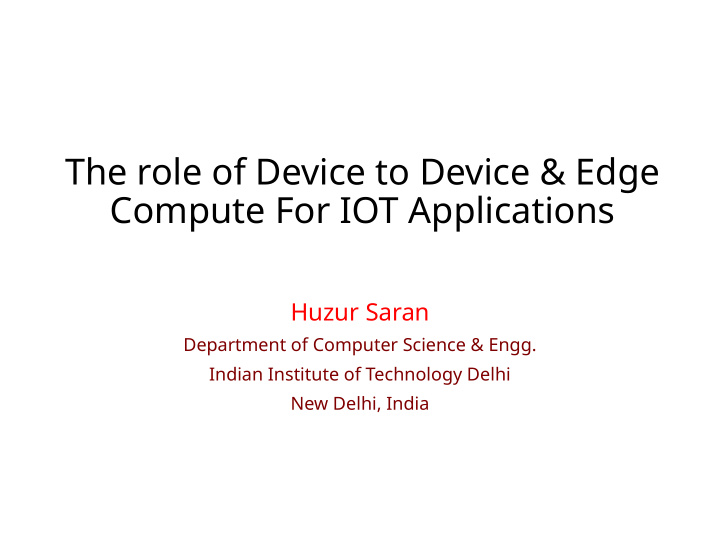



The role of Device to Device & Edge Compute For IOT Applications Huzur Saran Department of Computer Science & Engg. Indian Institute of Technology Delhi New Delhi, India
IoT Framework 5G standards based Interfaces and protocols available for IoT app & device developers on 5G network IoT apps like Air pollution monitoring, health care (will be explored with AIIMS) on network setup within IITD and will be made available to developers and manufacturers
Mobile Edge Computing • IoT devices are resource limited, yet many applications require large levels of compute power • Machine learning/deep learning • Video encoding and streaming • Vehicular applications Data aggregation and processing for roadside traffjc assistance • Mobile Edge Computing (MEC) has the potential to address IoT compute offmoad • Being introduced in 5G cellular networks • Brings computing power to within the radio access network (RAN) • Low latency, ability to leverage 5Gnetwork virtualization
MEC - Challenges • Performance • Active Probing for QoS • Low Latency Transport • When and what to offmoad? • Security: Edge Nodes should satisfy certain requirements • Tamper resistance • e.g. physical enclosures, disabling manufacturer debug/testmodes • Tamper (intrusion) detection • Detecting changes in normal operating conditions • Secure boot • Verify that all fjrmware in node is at latest version, code has not been modifjed
Overall Mechanism Sendin g Compiling Result Server Computin Code g.. Running Polling for Running Detecting Check Server Application Send function Result Sending Running server Candidate Reachability Refactoring Installing On Profjle JAR fjles to name and Modifjed functions for reachabilit and Wi-Fi App App mode parameters server App offmoad strength y LAN Offmoad info Server Compiling Code Running LAN Not Reachable
Active Probing for QoS • Achieved QoS can be very difgerent from advertised QoS • Estimate QoS without using up precious bandwidth resources • Active but non-invasive probing (using few packets) tools exist • E.g. : for available bandwidth Internet Probe packets • Variation in probe packet gaps, or packet loss reveal information about e2e path • Our fjnding: Existing probing tools (Spruce, Wbest, pathchirp, pathload etc.) perform poorly for 3G/4G networks • Developed own app 9
Low Latency Transport Protocols ● Important for Node 1 applications such as Machine compute offmoad g n i d a o ffm o ● Enhances network performance Node 2 AP g a Time to compute locally > Time for s s e m offmoading Node e 3 Node 4 *Star Shape Topology Time for offmoading = Time to send + Time to compute
Performance improvements (ns-3) Del Ack Throughp Del Ack Throughp AP paramet ut in Mbps paramet ut in Mbps er “d” er “d” 0 10.34 0 10.49 2 9.21 2 12.29 4 9.92 4 12.77 dynamic 13.58 dynamic 14.26 Lossy environment (4-5%) Lossless environment • Lossless case: TCP proximity gives 35% throughput improvement • Robust in the lossy case
Detecting Offmoadable functions Find functions with (We are considering high high to moderate call frequency functions in calling freq case if there are recursive calls) Analyze from the call graph If called very No frequently Yes from parent functions Can offmoad the Can not offmoad functions the functions Analyze memory stop accesses in the functions
Experimental Setup • Server-Side Specifjcation • x86-64 architecture (Intel Core-i7-3770S) ,3.1 GHz frequency, CPU Cache 8192K, 8GB RAM running Linux. • Client-Side Specifjcation • Android Device ( Google nexus 4) with ARM v7 Instruction set (Qualcomm Snapdragon S4 pro SOC) ,1.7GHz frequency, 2GB RAM, CPU Cache(L0: 4 KB + 4 KB, L1: 16 KB + 16 KB , L2: 2 MB) running on Android 5.1. • Network Specifjcation • Institute WI-FI Network (802.11b/g). 13
VIDEO STITCHING BENCHMARK • Video Stitching is the process of combining the images/video frames with overlapping fjelds of view to produce a panorama image. • In this benchmark, the video is captured and fjnally the stitched image is displayed. • Based on the video frame rate, certain frames are fjltered out for stitching .
VIDEO STITCHING CONTD.. • Next, If all the offmoading criteria are satisfjed then the frames will be sent to the server and perform stitching at server side and send back the resulting image. • Otherwise computation is performed at the device. • Stitching computation time varies based on the video length, video resolution. • It has applications such as satellite imaging and medical imaging
Video Stitching Benchmark Results
Time breakup of offmoading for Video Stitching Benchmark Video Video Total TCP Commun Server resolution length offmoad handshak ication computatio time e time n time 480 X 320 6 sec 5.80 sec 8 ms 2.3 sec 3.5 sec 640 X 480 6 sec 7.29 sec 10 ms 3.5 sec 3.78 sec 720 X 480 6 sec 8.79 sec 20 ms 4.37 sec 4.4 sec
Image Sharpener Benchmark • Image Sharpening refers to enhancing the visual quality of the image by increasing the high frequency components in it. • For this benchmark we fjrst performed program analysis using SOOT, and detected the ofg loadable functions. • Then the original application was modifjed to add the offmoad automation code.
Image Sharpener Results
Mean and Std deviation values ARM processor offmoad Atom processor offmoad time time Image Mean time Std deviation Mean time Std deviation resolution (s) (s) (s) (s) 640 X 480 0.85 0.07 0.73 0.03 1280x720 2.51 0.08 1.93 0.08 1920x1080 4.50 0.06 4.25 0.16 2592x1944 10.63 0.09 10.03 0.26
Recommend
More recommend